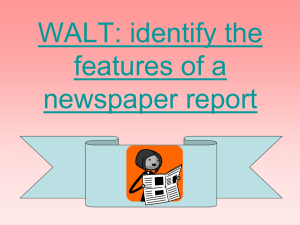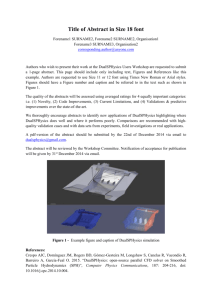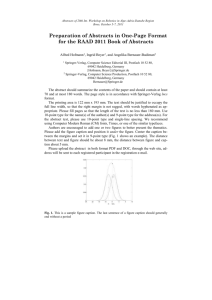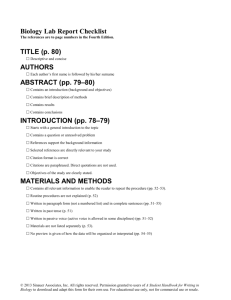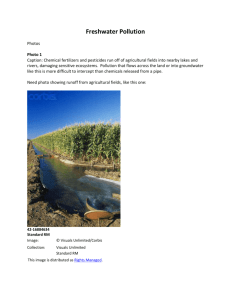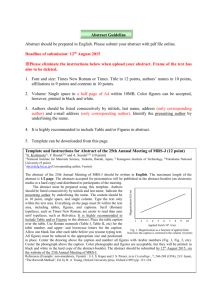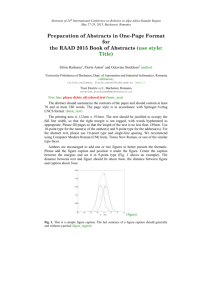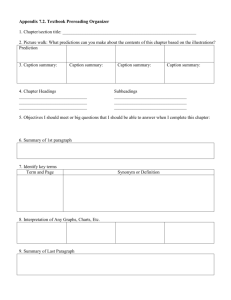Living conditions: refers to photos of people in shelters, people who
advertisement
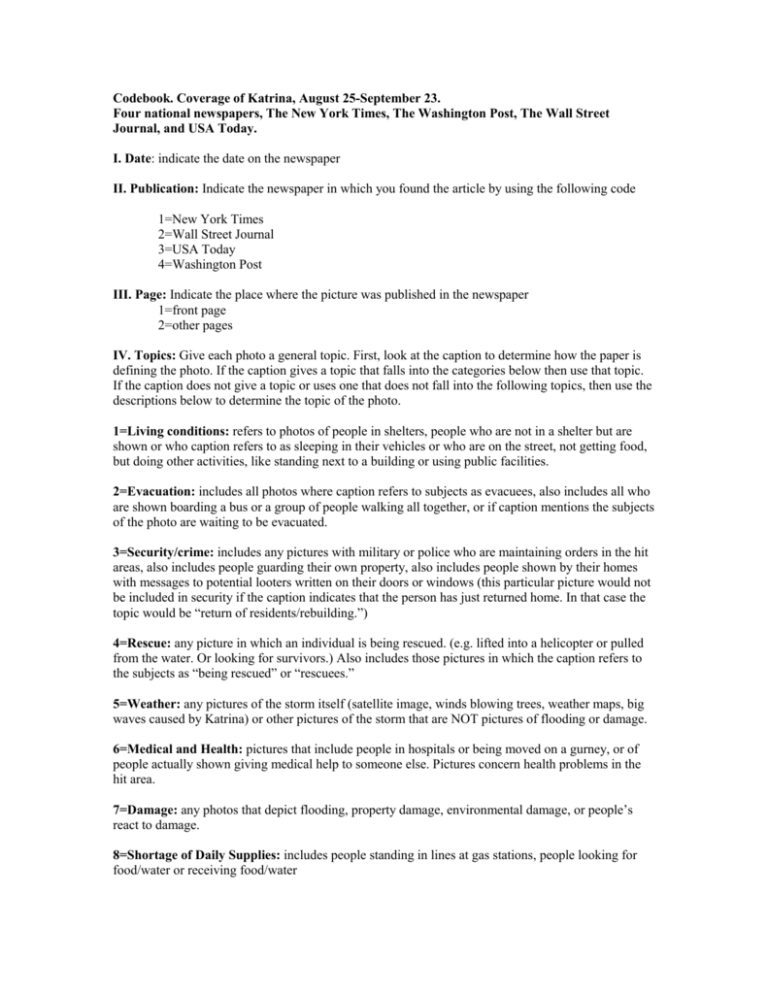
Codebook. Coverage of Katrina, August 25-September 23. Four national newspapers, The New York Times, The Washington Post, The Wall Street Journal, and USA Today. I. Date: indicate the date on the newspaper II. Publication: Indicate the newspaper in which you found the article by using the following code 1=New York Times 2=Wall Street Journal 3=USA Today 4=Washington Post III. Page: Indicate the place where the picture was published in the newspaper 1=front page 2=other pages IV. Topics: Give each photo a general topic. First, look at the caption to determine how the paper is defining the photo. If the caption gives a topic that falls into the categories below then use that topic. If the caption does not give a topic or uses one that does not fall into the following topics, then use the descriptions below to determine the topic of the photo. 1=Living conditions: refers to photos of people in shelters, people who are not in a shelter but are shown or who caption refers to as sleeping in their vehicles or who are on the street, not getting food, but doing other activities, like standing next to a building or using public facilities. 2=Evacuation: includes all photos where caption refers to subjects as evacuees, also includes all who are shown boarding a bus or a group of people walking all together, or if caption mentions the subjects of the photo are waiting to be evacuated. 3=Security/crime: includes any pictures with military or police who are maintaining orders in the hit areas, also includes people guarding their own property, also includes people shown by their homes with messages to potential looters written on their doors or windows (this particular picture would not be included in security if the caption indicates that the person has just returned home. In that case the topic would be “return of residents/rebuilding.”) 4=Rescue: any picture in which an individual is being rescued. (e.g. lifted into a helicopter or pulled from the water. Or looking for survivors.) Also includes those pictures in which the caption refers to the subjects as “being rescued” or “rescuees.” 5=Weather: any pictures of the storm itself (satellite image, winds blowing trees, weather maps, big waves caused by Katrina) or other pictures of the storm that are NOT pictures of flooding or damage. 6=Medical and Health: pictures that include people in hospitals or being moved on a gurney, or of people actually shown giving medical help to someone else. Pictures concern health problems in the hit area. 7=Damage: any photos that depict flooding, property damage, environmental damage, or people’s react to damage. 8=Shortage of Daily Supplies: includes people standing in lines at gas stations, people looking for food/water or receiving food/water 9=Return of residents/Rebuilding: caption mentions return of subject(s), people standing outside their homes. Photos of reconstruction or of new homes being built (whether they are in New Orleans or built elsewhere and shipped). Also any caption that mentions return or rebuilding after Katrina.) 10=Government response: photos with politicians meeting or of President Bush surveying damage, meeting survivors, or visiting the affected area. Also, if caption refers to political fallout or political meetings. 11=Death: photos of corpses, photos of memorizing people who died in Katrina hit. 12=International Response: caption refers to comments made by citizens or politicians of foreign countries, international aid being sent, arriving, or being distributed. 13=Social response: citizens showing support for New Orleans or victims in Katrina in one way or another (attending rally or fundraiser, also fans of N.O. football team expressing support, donations by celebrities); other U.S. citizens’ responses 14=Preparedness: people prepared for the possible hit of Katrina, e.g. store closes earlier. 15=Indirect Effects: e.g. plane delayed, oil price raised… 16=Media’s Response: e.g. journalist’s log, on-spot reports, media’s reaction to Katrina. V. Number of people in the photo: This category asks coders to count the number of people in the photo. Include corpses as one person. 1=One person 2= Two persons 3= Three persons 4= Four or more people 5=None VI. Code the three most prominent people: This category requires coders to determine the three most prominent people in the photo. a. For photos with three or fewer people in the photo, these will be considered the most prominent. b. If three out of the five categories below can be coded, please choose the three most prominent people. otherwise code “N/A” for the all of the categories below. c. If a photo contains more than three people, choose the people that catch your eye first and are the dominant figures in the photograph. d. These are the three largest, centered, active and most visible persons in the photo. This can include someone who’s back is to the camera. (need to satisfy rule b first) e. If the photo is of an unintelligible mass of people, then code “N/A” for all of the categories below. The three most prominent people will be known as persons 1, 2 and 3, and will each be coded for gender, age, race, social identity and activity. For people situated on a horizontal line, count left to right, so person No. 1 is the furthest to the left, person No. 2 is in the center and person No. 3 is furthest to the right. If someone is carrying someone else, use the placement of the heads to determine the order from left to right. For persons pictured on a straight line, person No. 1 is the person nearest the top of the photo, person No. 2 is in the middle and person No. 3 is on the bottom of the photo. Gender: For the three most prominent people in the photo, code for the gender of each person. When possible, use the caption as a guide when the caption identifies persons by name. 1=Male 2=Female 3=Unknown 9=N/A Age: This category asks coders to code the age of each of the three prominent persons in the picture. If the caption indicates the age of the subjects in the picture, follow the caption’s descriptions. If not, judge the age of the person by their appearance such as (height, wrinkles etc….) 1=Kid A kid/child/infant (e.g. a baby hugged by mom or dad, a child holding hands with a parent) 2=Young/Middle-Age The person looks like an adult but not very old. 3=Elderly The person has wrinkles and other features of an old person. 4=Unknown You can not tell the age of a person. 9=N/A There are no prominent persons in the picture. Race: This category asks coders to code the race of each of the three prominent persons in the picture. If the caption indicates the race of the subjects in the picture, follow the caption’s descriptions. If not, code the race of the person by their appearance such as (skin colors, ect…) 1=African-American The person has features of African-American. 2=Caucasian The person has features of a Caucasian. 3=Other The person is neither African-American nor Caucasian, but belongs to other ethnical groups, such as Asian, Spanish. 4=Unknown The race of the person can not be clearly identified based on the picture. 9=N/A There are no prominent persons in the picture. Social Identity: For the three most prominent people in the photo, code for the social identity of each. First use the caption as a guide and always first follow the terminology used in the caption to code for social identity. 1=survivor 2=corpse 3=policeman 4=President Bush 5=politician other than Bush 6=government relief worker 7=non-governmental aid worker 8=celebrity 9=evacuee Anyone who has obviously survived the hurricane. This includes people waiting to be rescued, people at their houses and people rebuilding their homes or places of work. Use this category for anyone who survived Hurricane Katrina but has not evacuated. (See below for evacuee and refugee explanations.) A corpse or someone obviously deceased. This includes local, state, federal (other than President Bush) and foreign politicians. This includes anyone from FEMA, or any other governmental non-elected person giving aid. This includes someone working for the Salvation Army, Red Cross, etc. This includes anyone not affiliated with a group as well, if they appear to be donating or assisting others in the relief effort. Also include people without a uniform who rescued or helped people. A celebrity is defined as a non-governmental public figure such as a movie or music star. This is anyone labeled an evacuee in the caption, anyone waiting to get on a vehicle to leave an affected area, anyone walking or visibly leaving an affected area. 10=refugee 11=soldier 12=supporter 13=medical worker 14=journalist 15=unknown 99=N/A This will only be used when the caption calls the agent a refugee. This includes the National Guard and all U.S. and foreign military personnel. This includes anyone at candlelight vigils, fans at sporting events, someone leading a rally on behalf of Hurricane Katrina victims, etc. This includes doctors, nurses and hospital staff. People who was identified as a reporter or who worked for a medium. People whose social identity can not be recognized based on the information that the caption and the picture provide. For photos with no persons only Activities: This category asks coders to code the activities of each of the three prominent persons in the picture. If the caption describes the activities, follow the caption. If not, rely on the best judgment that you can come with. 1=getting food and daily supplies 2=returning Home 3=Bbeing evacuated/rescued 4=self-guarding personal properties 5=signaling/waiting for helpers 6=looting 7=rescuing/evacuating people 8=maintaining orders 9=distributing supplies 10=surveying damages 11=discussing/address relief efforts 12=rallying/protesting/supporting 13=preparing for Katrina 14=reporting Katrina issues 15=looking for someplace safe 16=looking for survivors 99=N/A People who are offered or looking for daily supplies Local residents returning to their homes in a hit or evacuated area. People who are being evacuated or rescued by police, soldiers or a rescue team. People who guard their homes and properties People who make signals to seek for help. (e.g. people on the roof making help! Signs) And people in the condition of waiting for help. People who rescue and evacuate other people (often the soldiers and relief teams). People shown pulling people from water or lifting them into a boat or helicopter. People who maintain the order of the society (often soldiers and policemen). Police or military personnel patrolling streets or standing with guns. People who distribute daily supplies and food. People who check out the damages caused by hurricane Katrina in person or from vehicle or plane. People who discuss and address relief efforts or issues about Katrina. People who support/rally/protest for Katrina issues. People who prepare for the coming of Katrina Journalism activities. People who look for some place safer than their current conditions People who search for survivors in the hit area. Not applicable
